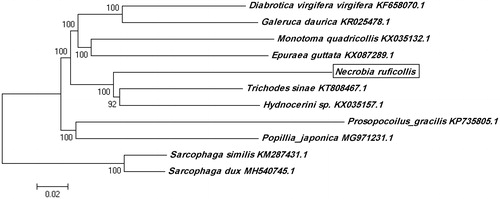Abstract
Necrobia ruficollis is a common beetle found on decaying corpse of forensic studies. The complete mitogenome of N. ruficollis was reported in the present study. The mitogenome was 14,443 bp in length totally, with a base composition of 39.4% for A, 10.3% for G, 37.9% for T, and 12.4% for C. The AT content bias was 77.3%. Twenty-two tRNA genes, 13 protein-coding genes (PCGs), and two rRNA genes were anotated. Most of tRNAs could folded into the typical clover-leaf structure, excepte tRNA-Ser (AGN). The result of phylogenetic analyses exhibited that N. ruficollis belong to the family Cleridae.
Beetles of genus Necrobia (Coleoptera: Cleridae) belong to the most frequent insect species spotted on animal or human carcass (Charabidze et al. Citation2014; Matuszewski and Mądra-Bielewicz Citation2016). Necrobia ruficollis, the red-shouldered beetle, could not only feed on dead body but also predate on the larvae of necrophagous fly which shared the same carcass resources (Knull Citation1951; Papp Citation1959; Peck and Thomas Citation1998). Together with some larder beetles (Dermestidae), such predating behavior could obviously decrease the population of flies breed on corpse. And such predatory pressure could results in an improper estimation of postmortem interval (PMI) after death in forensic investigation based on insect succession fauna data (Kulshrestha and Satpathy Citation2001; Menezes et al. Citation2006). Additionally, it also does harms to stock food like ham meat or dry fish (Knull Citation1951; Peck and Thomas Citation1998). Considering the potentially forensic application of Necrobia, efforts should be paid on the classification of such taxa in future studies (Fratczak and Matuszewski Citation2016). Here, we present the entire mitochondrial genome sequence of N. ruficollis for species identification and phylogenetic analysis (GenBank accession No: MK422543). All voucher specimens were assigned with a unique code and deposited in forensic insect herbarium of department of forensic science, Central South University (Changsha city).
The adults N. ruficollis samples were collected on pig carcasses in September 2018 from Changsha, China (28°9′N; 112°54′E). The samples were put into absolute ethyl alcohol and stored under −20 °C subsequently. DNA materials were extracted from adults of N. ruficollis for sequencing. Totally 11 overlapped PCR primers was used for the amplification of complete mitogenome of N. ruficollis. The procedures and methods of amplification were listed as below: a denaturation of DNA raw extraction was denatured under 94 °C for 4 min, then the annealing and elongating steps was conducted for 35 cycles as 94 °C, 30 s → 50 °C, 30 s → 72 °C, 1 min, followed by a final elongation at 72 °C for 10 min. The product of amplification was collected for DNA sequencing. This step was completed on automatic sequencing procedure of ABI PRISM 3730 (Applied Biosystems, Foster, CA). The complete circular mitochondrial genome structure was constructed according to the sequence overlapping and assembled into contigs using BioEdit (v7.0.9) software (Hall Citation1999). The sequences of potential protein coding regions were aligned and recognized manually with online data of NCBI. Then recognition of open reading frames feature structure was performed using stand-alone version of Open Reading Frame Finder (ORF finder).
The constructed complete mitochondrial genome of N. ruficollis was 14,443 bp in length. In total, 22 tRNA genes, 13 protein coding genes (PCG), and two rRNA genes were identified. Phylogenetic tree was constructed based on 13 PCGs of N. ruficollis with eight species of Order Coleoptera using Neighbor-joining methods (), and two species of Sarcophagidae was set as outgroups. All three species of family Cleridae was clustered as a group on the topological tree. This complete mitogenome of N. ruficollis will provide important supplementary data to family Cleridae.
Disclosure statement
No potential conflict of interest was reported by the authors.
Additional information
Funding
References
- Charabidze D, Colard T, Vincent B, Pasquerault T, Hedouin V. 2014. Involvement of larder beetles (Coleoptera: Dermestidae) on human cadavers: a review of 81 forensic cases. Int J Legal Med. 128:1021–1030.
- Fratczak K, Matuszewski S. 2016. Classification of forensically-relevant larvae according to instar in a closely related species of carrion beetles (Coleoptera: Silphidae: Silphinae). Forensic Sci Med Pathol. 12:193–197.
- Hall TA. 1999. BioEdit: a user-friendly biological sequence alignment program for Windows 95/98/NT. Nucleic Acids Symp Ser. 41:95–98.
- Knull JN. 1951. The checkered beetles of Ohio (Coleoptera: Cleridae). Ohio Bio Surv Bull. 8:268–350.
- Kulshrestha P, Satpathy DK. 2001. Use of beetles in forensic entomology. Forensic Sci Int. 120:15–17.
- Matuszewski S, Mądra-Bielewicz A. 2016. Validation of temperature methods for the estimation of pre-appearance interval in carrion insects. Forensic Sci Med Pathol. 12:50–57.
- Menezes L, Rossi MN, Godoy W. 2006. The effect of refuge on Dermestes ater (Coleoptera: Dermestidae) predation on Musca domestica (Diptera: Muscidae): refuge for prey or the predator? J Insect Behav. 19:717–729.
- Papp CS. 1959. Concerning North American Necrobia. South Calif Acad Sci Bull. 58:162–165.
- Peck SB, Thomas MC. 1998. A distributional checklist of the beetles (Coleoptera) of Florida. Arthropods Florida Neighboring Land Areas. 16:180.

